美音和英音的总结
- 格式:pdf
- 大小:1.02 MB
- 文档页数:16
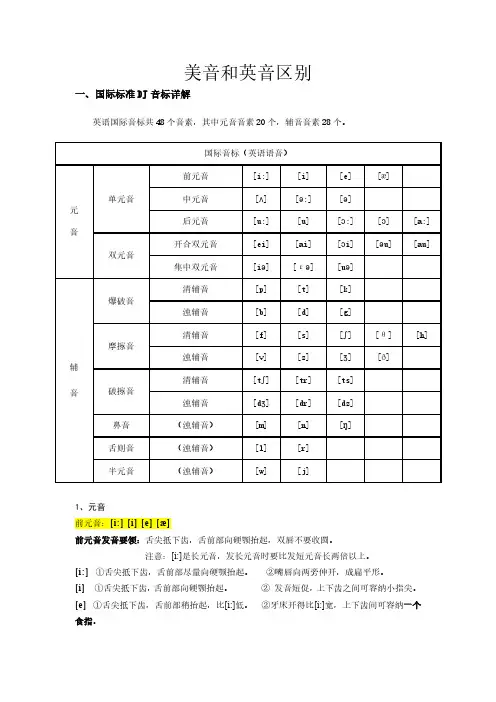
美音和英音区别一、国际标准DJ音标详解英语国际音标共48个音素,其中元音音素20个,辅音音素28个。
1、元音前元音:[i:] [i] [e] [æ]前元音发音要领:舌尖抵下齿,舌前部向硬颚抬起,双唇不要收圆。
注意:[i:]是长元音,发长元音时要比发短元音长两倍以上。
[i:] ①舌尖抵下齿,舌前部尽量向硬颚抬起。
②嘴唇向两旁伸开,成扁平形。
[i]①舌尖抵下齿,舌前部向硬颚抬起。
②发音短促,上下齿之间可容纳小指尖。
[e] ①舌尖抵下齿,舌前部稍抬起,比[i:]低。
②牙床开得比[i:]宽,上下齿间可容纳一个食指。
[æ] ①舌尖抵下齿。
②双唇向两旁平伸,嘴张开比e大,两齿间可以容纳食指和中指。
中元音:[ʌ] [ǝ:] [ǝ]中元音发音要领:舌尖抵住下齿,但不如发前元音时抵得那样紧。
舌身的中部隆起,扁唇(双唇不要收圆)。
[ǝ:] ①舌中部稍抬起。
②双唇和发[i:]时相似。
[ǝ]①舌中部抬起。
②牙床半开半合,短促有力。
[ʌ] ①舌中部稍抬起。
②开口程度和[æ]相似,唇形扁。
后元音:[ɑ:] [ɔ] [ɔ:] [u] [u:]后元音发音要领:①舌尖不触下齿,舌身后缩,舌后部向软颚抬起,除[ɑ:]外,双唇要收圆。
②发[ɑ:][ɔ:][u:]时要注意长度,不要发得太短。
[ɑ:] 舌尖不触下齿,口张大,舌身平放后缩。
[ɔ] ①舌尖不触下齿,口张大,舌身尽量降低并后缩。
②双唇稍稍收圆。
[ɔ:] ①舌后部比发[ɔ]时抬得略高。
②双唇也收得更圆更小,并须用力向前突出。
[u] ①舌尖不触下齿, 舌后部向软颚抬起,舌身后缩。
②双唇收圆,稍向前突出。
[u:]双唇比发[u]时收得更圆更小,向前突出,舌后部比发[u]时抬得更高。
双元音:[ei] [ai] [ɔi] [ǝu] [au] [iǝ] [uǝ] [Ɛǝ]双元音发音要领:①由两个元音组成,发音时由第一个向第二个元音的部位滑动,但不完全到达第二个元音的部位。
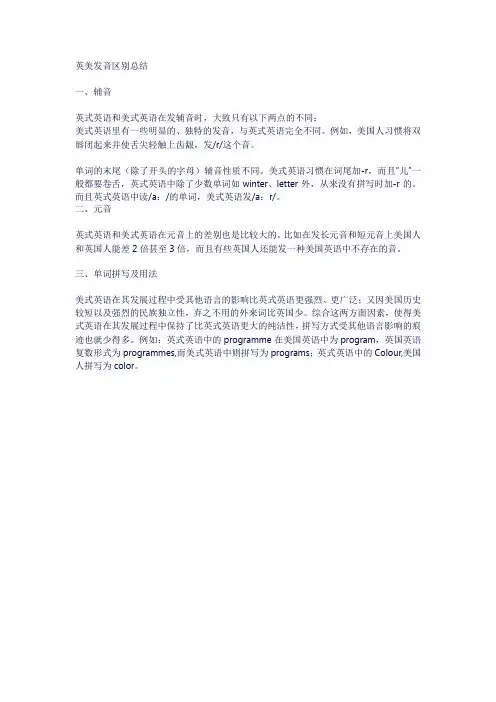
英美发音区别总结
一、辅音
英式英语和美式英语在发辅音时,大致只有以下两点的不同:
美式英语里有一些明显的、独特的发音,与英式英语完全不同。
例如,美国人习惯将双唇闭起来并使舌尖轻触上齿龈,发/r/这个音。
单词的末尾(除了开头的字母)辅音性质不同。
美式英语习惯在词尾加-r,而且“儿”一般都要卷舌,英式英语中除了少数单词如winter、letter外,从来没有拼写时加-r的。
而且英式英语中读/a:/的单词,美式英语发/a:r/。
二、元音
英式英语和美式英语在元音上的差别也是比较大的。
比如在发长元音和短元音上美国人和英国人能差2倍甚至3倍,而且有些英国人还能发一种美国英语中不存在的音。
三、单词拼写及用法
美式英语在其发展过程中受其他语言的影响比英式英语更强烈、更广泛;又因美国历史较短以及强烈的民族独立性,弃之不用的外来词比英国少。
综合这两方面因素,使得美式英语在其发展过程中保持了比英式英语更大的纯洁性,拼写方式受其他语言影响的痕迹也就少得多。
例如:英式英语中的programme在美国英语中为program,英国英语复数形式为programmes,而美式英语中则拼写为programs;英式英语中的Colour,美国人拼写为color。
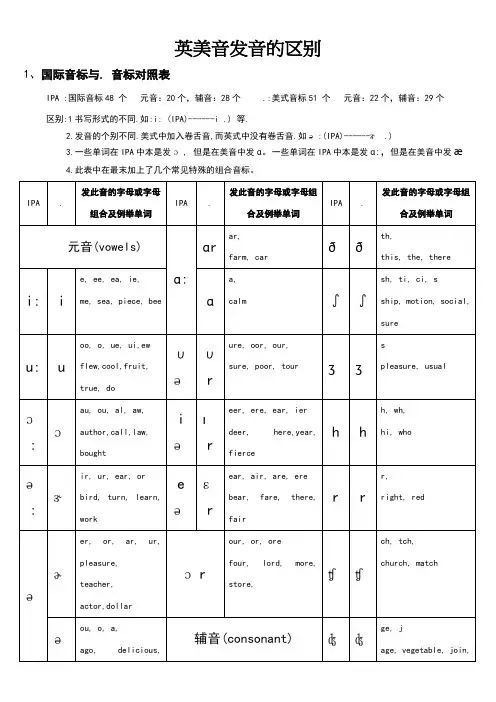
英美音发音的区别1、国际音标与. 音标对照表IPA :国际音标48 个元音:20个,辅音:28个 .:美式音标51 个元音:22个,辅音:29个区别:1书写形式的不同.如:i: (IPA)------i .) 等.2.发音的个别不同.美式中加入卷舌音,而英式中没有卷舌音.如ə:(IPA)------ɝ .)3.一些单词在IPA中本是发ɔ, 但是在美音中发ɑ。
一些单词在IPA中本是发ɑ:,但是在美音中发æ4.此表中在最末加上了几个常见特殊的组合音标。
2、英美音发音的区别差别一:美音中所有元音字母后的r字母全部要卷舌。
如 early work four firstThe early bird catches the worm.=Someone is successful because they were the first to do something.早起的鸟儿有虫吃。
捷足先登。
差别二:通常情况下,在英音中发/ɑ/音且后面没有接“r”的字母,美音读成/æ/。
如 ask pass lastcan Winter is past and spring has come at last. 冬天过去了,春天终于来临了。
差别三:小嘴变大嘴。
通常情况下,英音中短/ɔ/在美音中基本变成了大嘴的/ɑ/音。
如possible boss not . Nothing is impossible.没有什么不可能You’re the boss.你做主差别四:通常情况下,在美音中尾音“tle”和“ter”的/t/几乎读成了/d/。
如 little better I hope you will be better soon. 我希望你能很快好起来。

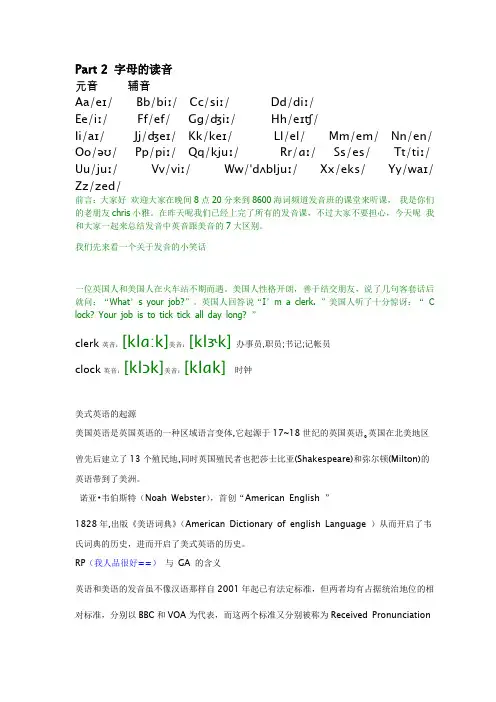
Part 2 字母的读音元音辅音Aa/eɪ/ Bb/biː/ Cc/siː/ Dd/diː/Ee/iː/ Ff/ef/ Gg/ʤiː/ Hh/eɪʧ/Ii/aɪ/ Jj/ʤeɪ/ Kk/keɪ/ Ll/el/ Mm/em/ Nn/en/ Oo/əʊ/ Pp/piː/ Qq/kjuː/ Rr/ɑː/ Ss/es/ Tt/tiː/ Uu/juː/ Vv/viː/ Ww/ˈdʌbljuː/Xx/eks/ Yy/waɪ/ Zz/zed/前言:大家好欢迎大家在晚间8点20分来到8600海词频道发音班的课堂来听课,我是你们的老朋友chris小雅。
在昨天呢我们已经上完了所有的发音课,不过大家不要担心,今天呢我和大家一起来总结发音中英音跟美音的7大区别。
我们先来看一个关于发音的小笑话一位英国人和美国人在火车站不期而遇。
美国人性格开朗,善于结交朋友,说了几句客套话后就问:“What’s your job?”。
英国人回答说“I’m a clerk. ”美国人听了十分惊讶:“C lock? Your job is to tick tick all day long? ”clerk英音:[klɑ:k]美音:[klɝk]办事员,职员;书记;记帐员clock英音:[klɔk]美音:[klɑk]时钟美式英语的起源美国英语是英国英语的一种区域语言变体,它起源于17~18世纪的英国英语。英国在北美地区曾先后建立了13个殖民地,同时英国殖民者也把莎士比亚(Shakespeare)和弥尔顿(Milton)的英语带到了美洲。
诺亚•韦伯斯特(Noah Webster),首创“American English ”1828年,出版《美语词典》(American Dictionary of english Language )从而开启了韦氏词典的历史,进而开启了美式英语的历史。
RP(我人品很好==)与GA 的含义英语和美语的发音虽不像汉语那样自2001年起已有法定标准,但两者均有占据统治地位的相对标准,分别以BBC和VOA为代表,而这两个标准又分别被称为Received Pronunciation(英语公认标准)和General American(美语普通话),在专业著述中常使用其缩写RP和G A。
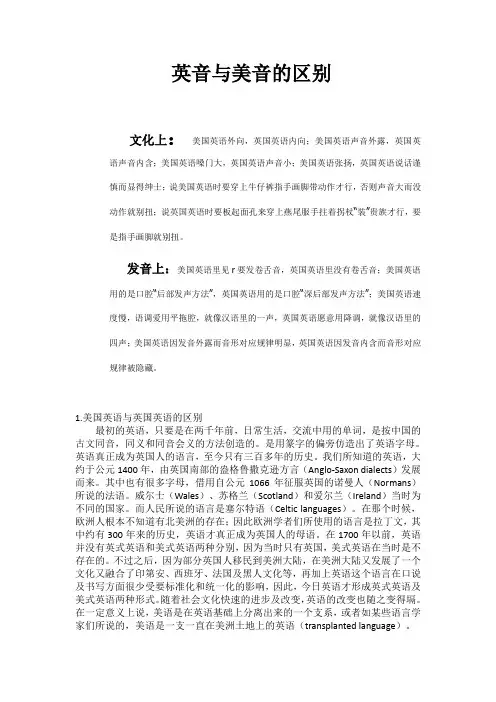
英音与美音的区别文化上:美国英语外向,英国英语内向;美国英语声音外露,英国英语声音内含;美国英语嗓门大,英国英语声音小;美国英语张扬,英国英语说话谨慎而显得绅士;说美国英语时要穿上牛仔裤指手画脚带动作才行,否则声音大而没动作就别扭;说英国英语时要板起面孔来穿上燕尾服手拄着拐杖“装”贵族才行,要是指手画脚就别扭。
发音上:美国英语里见r要发卷舌音,英国英语里没有卷舌音;美国英语用的是口腔“后部发声方法”,英国英语用的是口腔“深后部发声方法”;美国英语速度慢,语调爱用平拖腔,就像汉语里的一声,英国英语愿意用降调,就像汉语里的四声;美国英语因发音外露而音形对应规律明显,英国英语因发音内含而音形对应规律被隐藏。
1.美国英语与英国英语的区别最初的英语,只要是在两千年前,日常生活,交流中用的单词,是按中国的古文同音,同义和同音会义的方法创造的。
是用篆字的偏旁仿造出了英语字母。
英语真正成为英国人的语言,至今只有三百多年的历史。
我们所知道的英语,大约于公元1400年,由英国南部的盎格鲁撒克逊方言(Anglo-Saxon dialects)发展而来。
其中也有很多字母,借用自公元1066年征服英国的诺曼人(Normans)所说的法语。
威尔士(Wales)、苏格兰(Scotland)和爱尔兰(Ireland)当时为不同的国家。
而人民所说的语言是塞尔特语(Celtic languages)。
在那个时候,欧洲人根本不知道有北美洲的存在;因此欧洲学者们所使用的语言是拉丁文,其中约有300年来的历史,英语才真正成为英国人的母语。
在1700年以前,英语并没有英式英语和美式英语两种分别,因为当时只有英国,美式英语在当时是不存在的。
不过之后,因为部分英国人移民到美洲大陆,在美洲大陆又发展了一个文化又融合了印第安、西班牙、法国及黑人文化等,再加上英语这个语言在口说及书写方面很少受要标准化和统一化的影响,因此,今日英语才形成英式英语及美式英语两种形式。
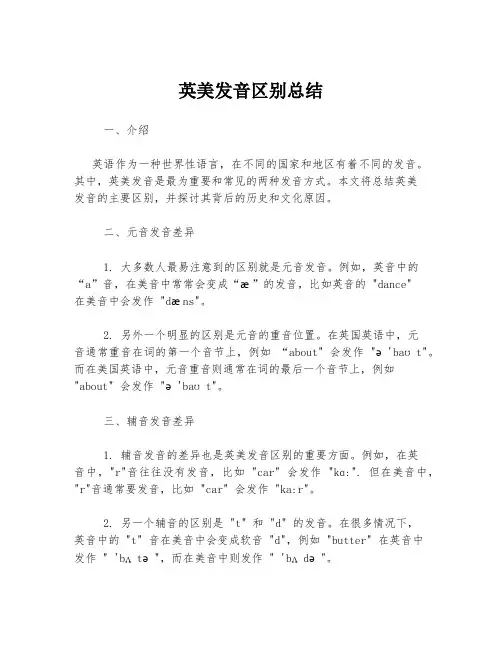
英美发音区别总结一、介绍英语作为一种世界性语言,在不同的国家和地区有着不同的发音。
其中,英美发音是最为重要和常见的两种发音方式。
本文将总结英美发音的主要区别,并探讨其背后的历史和文化原因。
二、元音发音差异1. 大多数人最易注意到的区别就是元音发音。
例如,英音中的“a”音,在美音中常常会变成“æ”的发音,比如英音的 "dance"在美音中会发作 "dæns"。
2. 另外一个明显的区别是元音的重音位置。
在英国英语中,元音通常重音在词的第一个音节上,例如“about" 会发作 "ǝ'baʊt"。
而在美国英语中,元音重音则通常在词的最后一个音节上,例如"about" 会发作 "ǝ'baʊt"。
三、辅音发音差异1. 辅音发音的差异也是英美发音区别的重要方面。
例如,在英音中,"r"音往往没有发音,比如 "car" 会发作 "kɑ:". 但在美音中,"r"音通常要发音,比如 "car" 会发作 "ka:r"。
2. 另一个辅音的区别是 "t" 和 "d" 的发音。
在很多情况下,英音中的 "t" 音在美音中会变成软音 "d",例如 "butter" 在英音中发作 " 'bʌtǝ",而在美音中则发作 " 'bʌdǝ"。
四、历史和文化原因英美发音的区别主要源自于英国殖民地时期的移民潮和语言演变。
由于移民潮和各地文化的影响,英语在不同地区逐渐形成了独特的发音方式。
例如,北美地区的发音受到了英格兰、苏格兰、威尔士和爱尔兰等地的移民影响,形成了独特的美国英语口音。
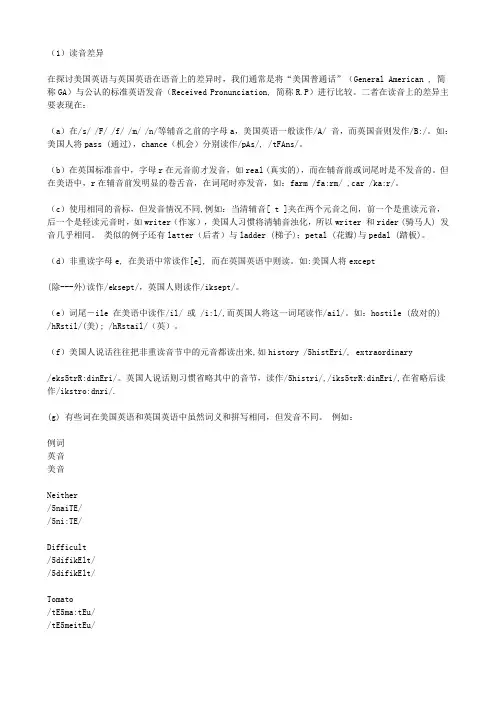
(1)读音差异在探讨美国英语与英国英语在语音上的差异时,我们通常是将“美国普通话”(General American , 简称GA)与公认的标准英语发音(Received Pronunciation, 简称R.P)进行比较。
二者在读音上的差异主要表现在:(a)在/s/ /F/ /f/ /m/ /n/等辅音之前的字母a,美国英语一般读作/A/ 音,而英国音则发作/B:/。
如:美国人将pass (通过),chance(机会)分别读作/pAs/, /tFAns/。
(b)在英国标准音中,字母r在元音前才发音,如real (真实的),而在辅音前或词尾时是不发音的。
但在美语中,r在辅音前发明显的卷舌音,在词尾时亦发音,如:farm /fa:rm/ ,car /ka:r/。
(c)使用相同的音标,但发音情况不同,例如:当清辅音[ t ]夹在两个元音之间,前一个是重读元音,后一个是轻读元音时,如writer(作家),美国人习惯将清辅音浊化,所以writer 和rider (骑马人) 发音几乎相同。
类似的例子还有latter(后者)与ladder (梯子);petal (花瓣)与pedal (踏板)。
(d)非重读字母e, 在美语中常读作[e], 而在英国英语中则读。
如:美国人将except(除---外)读作/eksept/,英国人则读作/iksept/。
(e)词尾―ile 在美语中读作/il/ 或 /i:l/,而英国人将这一词尾读作/ail/。
如:hostile (敌对的) /hRstil/(美); /hRstail/(英)。
(f)美国人说话往往把非重读音节中的元音都读出来,如history /5histEri/, extraordinary/eks5trR:dinEri/。
英国人说话则习惯省略其中的音节,读作/5histri/,/iks5trR:dinEri/,在省略后读作/ikstro:dnri/.(g) 有些词在美国英语和英国英语中虽然词义和拼写相同,但发音不同。
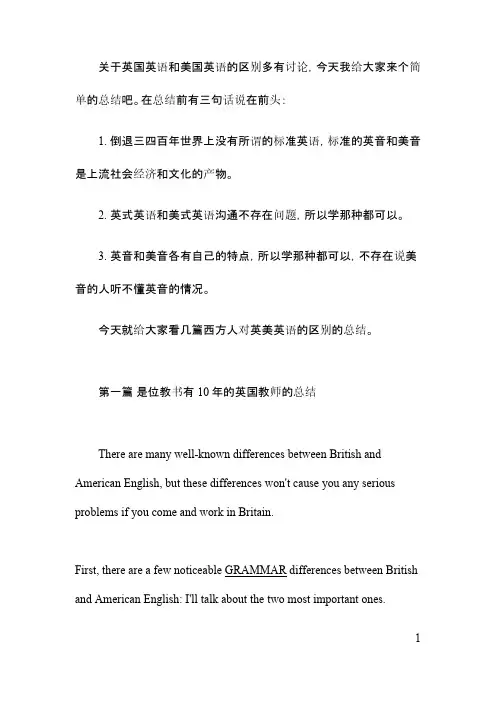
First of all, when Americans make sentencesusing 'just', 'already' or 'yet', they normally use the past simple tense, while in Britain, we use the present perfect.So an American, for example, might say:"I already had lunch.""She didn't arrive yet."And a British person would say:"I've already had lunch." - That's "I have already had lunch." Or... "She hasn't arrived yet."Also, in Britain we often use 'have got' or 'has got' when we talk about possession, while Americans generally just use 'have' or 'has'.For example, I think many Americans would be unfamiliar with the British slang word 'naff', which means 'un-cool' or 'poor-quality'.On the other hand, a Brit (a British person) might be very confused by a sentence like:"The café is kitty-corner to the pharmacy."This means that the café is diagonally opposite to the pharmacy, but we don't have the word'kitty-corner' in British English.Another example would be telling the time...If we want to describe 2:45 in Britain, we might say:"Quarter to three", or 3:15 would be "Quarter past three".On the other hand, in America, these might be:"Quarter of three" for 2:45, or "Quarter after three" for 3:15.It's another small difference, but it's one that's not going to cause seriousmovies.I should also point out that regional English can be an important thing to think about. Not everyone in Britain talks like James Bond. There are some regional accents in Britain which you don't hear so often in the movies, and these might be a bit more difficult to get used to.However, I'd like to finish by saying that many, many Americans live and work in Britain, and they don't have any serious language problems at all. So, Brittney, my advice to you is: don't worry about the language, you'll be fine!第二篇关于两种拼写牛津在线词典给了详细的说明British and American spellingThere are several areas in which British and American spelling are different. These are the main ones to be aware of.Aside from spelling differences, many items and practices have different names in British and American English. To explore further, see .第三篇这位老师给了更详细的一个说明IntroductionSpeakers of American English generally use the present perfect tense (have/has + past participle) far less than speakers of British English. In spoken American English it is very common to use the simple past tense as an alternative in situations where the present perfect would usually have been used in British English. The two situations where this is especially likely are:(i) In sentences which talk about an action in the past that has an effect in the present:American English / British EnglishJenny feels ill. She ate too much.Jenny feels ill. She's eaten too much.I can't find my keys. Did you see them anywhere?I can't find my keys. Have you seen them anywhere? (ii) In sentences which contain the words already, just or yet: American English / British EnglishA: Are they going to the show tonight?B: No. They already saw it.A: Are they going to the show tonight?B: No. They've already seen it.A: Is Samantha here?B: No, she just left.A: Is Samantha here?B: No, she's just left.A: Can I borrow your book?B: No, I didn't read it yet.A: Can I borrow your book?B: No, I haven't read it yet.1. Verb agreement with collective nounsIn British English collective nouns, (i.e. nouns referring to particular groups of people or things), (e.g. staff , government, class, team) can be followed by a singular or plural verb depending on whether the group is thought of as one idea, or as many individuals, e.g.:My team is winning.The other team are all sitting down.In American English collective nouns are always followed by a singular verb, so an American would usually say:Which team is losing?whereas in British English both plural and singular forms of the verb are possible, as in:Which team is/are losing?2. Use of delexical verbs have and takeIn British English, the verb have frequently functions as what is technically referred to as a delexical verb, i.e. it is used in contexts where it has very little meaning in itself but occurs with an object noun which describes an action, e.g.:I'd like to have a bath.Have is frequently used in this way with nouns referring to common activities such as washing or resting, e.g.:She's having a little nap.I'll just have a quick shower before we go out.In American English, the verb take, rather than have, is used in these contexts, e.g.:Joe's taking a shower.I'd like to take a bath.Let's take a short vacation.Why don't you take a rest now?3. Use of auxiliaries and modalsIn British English, the auxiliary do is often used as a substitute for a verb when replying to a question, e.g.:A: Are you coming with us?B: I might do.In American English, do is not used in this way, e.g.:A: Are you coming with us?B: I might.In British English needn't is often used instead of don't need to, e.g.: They needn't come to school today.They don't need to come to school today.In American English needn't is very unusual and the usual form is don't need to, i.e.:They don't need to come to school today.In British English, shall is sometimes used as an alternative to will to talk about the future, e.g.:I shall/will be there later.In American English, shall is unusual and will is normally used.In British English shall I / we is often used to ask for advice or an opinion, e.g.:Shall we ask him to come with us?In American English should is often used instead of shall, i.e.:Should we ask him to come with us?4. Use of prepositionsIn British English, at is used with many time expressions, e.g.:at Christmas/five 'o' clockat the weekendIn American English, on is always used when talking about the weekend, not at, e.g.:Will they still be there on the weekend?She'll be coming home on weekends.In British English, at is often used when talking about universities or other institutions, e.g.:She studied chemistry at university.In American English, in is often used, e.g.:She studied French in high school.In British English, to and from are used with the adjective different, e.g.:This place is different from/to anything I've seen before.In American English from and than are used with different, e.g.:This place is different from/than anything I've seen before.In British English to is always used after the verb write, e.g.:I promised to write to her every day.In American English, to can be omitted after write, i.e.:I promised to write her every day.5. Past tense formsThe two varieties of English most widely found in print and taught around the world are British and American - it is therefore important for teachers to be aware of the major differences between the two. And while lexical differences are the easiest ones to notice, a knowledge of grammatical and phonological differences can be useful not only for teachers to be aware of, but also to be able to deal with should they come up in class.Which is better?An important point to make is that different doesn’t mean wrong. Comments such as “American English is inferior to British English”, or “American English is better than British English” have no solid basis other than the speaker’s opinion. The truth is that no language or regional variety of language is inherently better or worse than another. They are just different. Students will often have very firm beliefs on which English they think is better/easier to understand/clearer etc. While it may be true for that particular individual, there is no evidence to suggest that one variety is easier to learn or understand than the other.Materials and varietiesIf you are an American English speaker teaching with a British coursebook or vice versa, what do you say when the book is different from your English? The answer here is to point out the difference. The differences are not so numerous as to overload the students and often can be easily dealt with. For example, if you are an American English speaker using a lesson that has just included “at the weekend” it takes very little time to point out that in American English people say “on the weekend”. Accept either from your students then. If you decide to go along with the book and say “at the weekend” yourself, you’ll probably sound unnatural, and “on the weekend” might slip out anyway!Exams and essay writingIn most international exams, both varieties of English are accepted. However, while writing for an international exam (or writing in English generally) students should try to remain consistent. That means if they favour (or favor) American spelling and grammar, they should stick to that convention for the whole piece of writing.What role do other varieties of English have in the classroom?Although British and American varieties are the most documented, there are of course many other varieties of English. Scotland, Ireland,。

(一)单词中字母“r”发音――“卷舌”的标志显而易“听”,卷舌音是美音区别于英音的一大特色。
请注意:美音中除了Mrs.中的“r”不卷舌之外,只要含有“r”字母的单词均要卷舌。
美音英音spare/speEr//speE/burglar/bErglEr//bE:glE/purpose/pErpEs//pE:pEs/最典型实例chairman, horse, dirty(二)在美音中/t/发音与/d/相近注意:美音中/t/ 出现在两个元音之间且处于非重读位置的时候,发音近似/d/,而不是完全等同。
我们这里用/d/来表示这个近似音。
美音英音city /sidi//siti/better/bedEr//betE/pretty/pridi//priti/最典型实例waiter, winter, actor, yesterday, chapter(三)听辨美音中的/A/字母a的发音出现在-ss, -st, -th, -ff, -ef, -nce 等前面时,美音把a读为/A/ 梅花英美音英音can’t/kAnt//ka:nt/last /lAst//la:st/Mask /mAsk//ma:sk/chance/tFAns//tFa:ns/advantage/EdvAntidV//Edva:ntidV/最典型实例answer, advance,a fter, ask, banana, branch, castle, commander, example, fast, France, glance, glass, half, last, etc.(四)由“hot dog”看字母“o”在美音中的发音字母“o” 在美音读为/a/而在英音中读为/R/美音英音bottle/batl//bCtl/popular/papjulE//pCpjulE/knock/nak//nCk/politician /palitiFEn//pClitiFEn/最典型实例odd, lock, pot, sock, watch, fog, nod, solve, rocket, monopoly(垄断), shop, etc.(五)字母u和ew在英音和美音的不同字母u和ew在l, d, n, t 之后,美音倾向于读/u/, 而英音倾向读/ju/美音英音Due/du://dju:/produce/prEdu:s//prEdju:s/attitude /Atitu:d//Atitju:d/student/stU:dEnt//stjU:dEnt/最典型实例value,opportunity,true,stupid,tune,supermarket,virtue,etc.(六)美音单词:发音与拼写一致最典型实例美音英音Clerk/klE:k//kla:k/ceremony/serimEuni//serimEni/Obey /Eubei//Ebei/dormitory /dCrmitCri//dC:mitri/secretary /sekritEri//sekritri/Epoch (新纪元)/epCk//i:pCk/(七)词尾特殊读音–ile在美音中“ile” 读为/l/, 在英音中读为/ail/高级口译听力历年最典型实例美音英音fertile (肥沃)/fE:tl//fE:tailhostile (敌意)/hastl//hRstaIlmissile (导弹)/missEl//missail/textile (纺织品) /tekstl//tekstail小帖士:除在词汇层面上英式英语和美式英语有发音的不同外,还有语调上的差别。
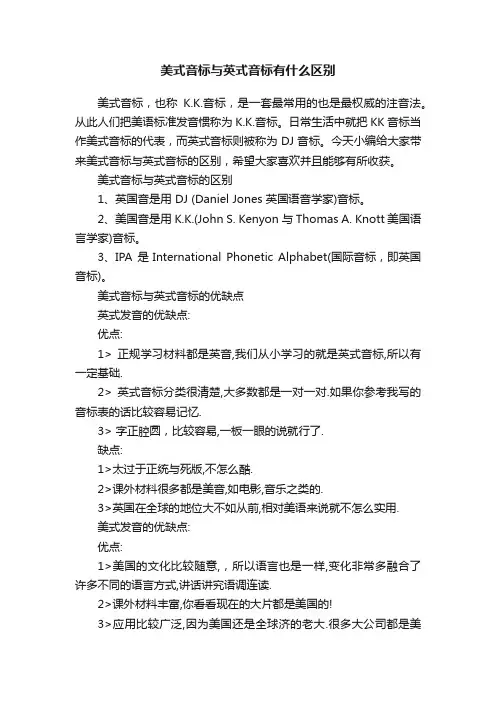
美式音标与英式音标有什么区别美式音标,也称K.K.音标,是一套最常用的也是最权威的注音法。
从此人们把美语标准发音惯称为K.K.音标。
日常生活中就把KK音标当作美式音标的代表,而英式音标则被称为DJ音标。
今天小编给大家带来美式音标与英式音标的区别,希望大家喜欢并且能够有所收获。
美式音标与英式音标的区别1、英国音是用 DJ (Daniel Jones 英国语音学家)音标。
2、美国音是用K.K.(John S. Kenyon 与 Thomas A. Knott美国语言学家)音标。
3、IPA 是International Phonetic Alphabet(国际音标,即英国音标)。
美式音标与英式音标的优缺点英式发音的优缺点:优点:1> 正规学习材料都是英音,我们从小学习的就是英式音标,所以有一定基础.2> 英式音标分类很清楚,大多数都是一对一对.如果你参考我写的音标表的话比较容易记忆.3> 字正腔圆,比较容易,一板一眼的说就行了.缺点:1>太过于正统与死版,不怎么酷.2>课外材料很多都是美音,如电影,音乐之类的.3>英国在全球的地位大不如从前,相对美语来说就不怎么实用.美式发音的优缺点:优点:1>美国的文化比较随意,,所以语言也是一样,变化非常多融合了许多不同的语言方式,讲话讲究语调连读.2>课外材料丰富,你看看现在的大片都是美国的!3>应用比较广泛,因为美国还是全球济的老大.很多大公司都是美国公司.缺点:1>对于初学者来说,把美音学好比把英音学好要更难.因为美式发音要注意的变化太多.尤其是元音的变化2>在中国,正统的学习材料没有应用美音,所以大多数学生的基础还是在英音上,如果基础不好换去学美音会产生非常多的困惑.美式音标学习建议1.先熟练掌握英式发音.我在实际的教学过程中一般是教英式音标!原因是比较容易学,美式发音太容易把初学者搞混乱,很多人以为自已把初中高中所学的知识全忘了,但其实并不是这样,发音法还是会有残留在你的大脑里.当你没基础又没有指导的时候就会非常乱!2>在建立了一定的语言基础后,去学习美音与英音的差别3>了解美音和英音的区别后,把所有读外听力材料换成美式发音只要你把环境换成了美式发音的环境,其实你慢慢就会开始发美音.只是你自已没察觉罢了4>着重练习两种音标差别较大的发音.5>着重学习美音的发音技巧,完全转去美音!英语音标学习方法第一阶段为初学期:这个阶段你首先要熟悉音标,能做到认识会读就可以了,有些发音可能不是很准也没有关系这很正常。
纯⼲货想了解英⾳美⾳的最⼤区别?看这⼀篇就够了!Flora带你学美语各位读者朋友们⼤家好!我是练习时长两年半的个⼈练习⽣……开下玩笑哈哈。
⼤家好!我是好久没出来溜达的Flora(仰天长笑)今天突然闪现是给⼤家送⼲货来啦。
其实关于英美⾳的差异我⽼早就想写了,因为听过很多对美⾳甚⾄是发⾳的偏见,所以今天正好可以借这个主题和⼤家聊聊。
话不多说,直奔主题。
温馨提⽰:详细发⾳指导可以听⾳频哟英⾳美⾳的主要区别?1.英语中的/ɒ/,在美语中⼀般发成/ɑ/⾳(嘴巴张⼤)例如:stop, impossible, job, hot, shot, cop, not, robber, doctor2.英语中的/ʌ/,在美语中⼀般发成/ə/⾳(唇部肌⾁呈放松状态)例如:up, fun, but, number, country, son, other, cup, nut, rubber3.英语中的/ɑː /,在美语中⼀般发成/æ/⾳例如:class, math, apple, angry, man, dance, answer, habit, fast, can’t, matter, half4. 美语中的/ər/⾳重点提醒⼀下,当英语中的/ʌ/读成美语中的/ə/时,其元⾳字母后若有r,则/ə/需与/r/连读,读作/ər/(⾆尖向上卷起)例如:worry, courage, encourage5. 元⾳字母后若跟有l,则该/l/的发⾳较之英语会更轻更长(⾆尖抵住上齿后边的齿龈,做发辅⾳/l/的⾆位,但不发出/l/的⾳)例如:call, tall, small这个⾳想发标准并不容易,因为⼤家平时说英语没有做这个⾆位的习惯,唯⼀的解决办法就是强迫⾃⼰多做,练⼀段时间就会了……吧6.美⾳中元⾳字母后⾯若跟有r,这个⾳节⼀定要卷⾆(⾆尖向上卷起)这是英⾳与美⾳最明显的区别。
同样地,如果该元⾳字母后没有r,⼀定不要卷⾆,不要卷⾆!⾝边真的有很多⼈以为美语就是⼀卷到底,连all, famous, because, delicious这些词都能读成卷⾆,听起来真的很诡异。
英美音区别小结英音发音靠前,字正腔圆,比较清脆生硬;而美音发音比较靠后,更鼻音化一些,听起来比较圆润。
一、卷舌音英音中r要发卷舌音,如early,spare,worse,before,prefer等比较好掌握。
不过,许多人把卷舌音当成了美音的招牌发音,无论读什么单词都要卷一下舌头,比如把China读成Chinar,idea读成idear,really读成rearlly,famous读成famours,结果闹出来很多笑话。
所以大家一定要牢记,单词中“有r才能卷,没r不能卷”。
就像because,idea,cause,doll,poll,college,modern等都是不能卷舌的。
二、长元音[α:]异化为[æ]字母a出现在-ass,-st,-th,-ff,-nce等组合前面,英音中[α:],美音中读[æ]。
如:can’t,chance,advantage,staff,answer,pass,advance,after,ask,banana,branch, castle,commander,example,fast,France,glance,glass,half,last等。
三、元音[ɔ:]和[ɔ]异化为介于[ɔ]和[α]之间的音发音时可以试着先念一个[ɔ],然后将嘴上下拉到与[α]等长,但注意把嘴的宽度控制在与[ɔ]一致。
如:water,popular,caught,bottle,rock,God,dog,hot,odd,dollar,watch,frog,monster, cross,stop,not等。
四、在字母d,t,s,st,n后面,半元音[j]弱化,将[ju:]念成[u]如:student,new,nuclear,due,Tuesday,tune,duty,suit等。
五、字母t由[t]浊化为[d]当[t]是组成音节的第一个成分时,发音保持不变,如today,tomato,tea等。
英音VS美音,史上最齐全的英美音区分秘籍!Q:什么是英音,什么是美音?最近常常有听众问起:'我们是学习的是英音还是美音,英美音到底有什么区别?'。
首先我们要知道什么是英音什么是美音→英音:即Received Pronunciation(简称“RP”,发音以BBC为代表)。
美音:General American(简称“GA”,发音以CNN为代表)。
为了让大家对英美音有更深一步的认识本期萨总就为大家带来英美音大辨析!英美音——差异大对比1.英美音的发音①字母r是否卷舌英美音最大的区别在于是否卷舌,英音不卷,美音卷,但有些迷恋美音的辣椒卷舌音发的有些过火(overdone),不该卷的地方也卷了,这就不好了哦。
卷舌的要领很简单,主要看字母组合中是否出现r,如果有就必须卷,这里所说的r都是在字母组合中出现在末尾,没有就一定不要卷(Mrs.除外)。
举个栗子:dirty、spare、purpose、horse特别注意:不该卷舌但经常被卷的单词,如:idea、famous▲注意:以辅音形式出现在音节开头的r,不管英音还是美音都要卷舌,因为要跟后面的元音进行拼读,不卷舌是无法完成的,如:rose、radio、road②重读闭音节中的字母o在重读闭音节中,字母o英音发/ɔ/,美音发靠近/a/的音(注意是靠近/a/,但不能完全发成/a/,下颌张开,口腔较大)。
举个栗子:watch、box、popular、knock、lock、pot、fog、rocket③字母/æ/音的发音在/ss/, /st/, /th/, /ff/, /nce/, /s/, /l/, /m/, /n/等辅音之前的字母a,美国英语一般读作/ æ / 音,而英国音则发作/a:/。
举个栗子:pass、last、path、staf、chance、castle、half。
▲注意:answer在美音中/a/音都会音变成/ æ /音。
英音与美音的区别( 1 ) 在/s/?/t/?/f/?/m/?/n/等辅音之后的字母a,美国英语一般读作/?/?音,而英国音则发作/a:/。
如:美国人将pass?(通过),chance(机会)分别读作/p?s/,?/t??ns/,ask,?task,?answer,?class,?can?t( 2 )在英国标准音中,字母r在元音前才发音,如real/ri?l/?(真实的),而在辅音前或词尾时是不发音的,?dear,?pair,?there。
但在美语中,r在辅音前发明显的卷舌音,在词尾时亦发音,如:farm?/farm/,/fa:m/?,?car?/kar/,/ka:/。
( 3 )例子还有( 4 )(除---外)( 5 ) ); /'h?sta?l/(英).( 6 ) 英音(7)/'d?kt?(r)/ 美/'dɑkt?(8)不加/?/音。
例如:hero 英/'h??r??/ 美/'h?ro?/ 英/?p??ri?d/ 美/?p?r??d/(9)美音把半元音及次元音省略。
在美音中字母u,以及字母组合ew, eu出现在字母t, d, n, l后面时发为/u/音,在英音中发为/ju/音。
例如:Tube 英/tju?b/ 美/tub/ New英/nju?/ 美/nu/(10)英式英语中只有单词开头的st sp sk中的t, p, k异化成d, b, g,而美式中t, k, p, tr等几个音,不论是在词头还是词尾,只要前面接s, 甚至是ci, ce, si, se等音节就一律异化。
例如:city second(11)美国人说话往往把非重读音节中的元音都读出来, 英国人说话则习惯省略其中的音节。
例如history 英/'h?stri/ 美/'h?st(?)ri/(12)当辅音/l/前后均有元音时,美音中更倾向于把它和前面的那个元音结合在一起,比如Australia这一单词,细心的同学会发现,美音中会读成stral--ia,而英音中会读成绝大多数人通常读的stra--lia。
英语是世界上最为流行的语言之一,而在英语中,26个字母的发音在英式和美式英语中有着不同的表达方式。
下面就让我们来详细了解一下这些发音的差异。
一、元音字母发音差异1. A/a/- 英式发音:[ei]- 美式发音:[æ]2. E/e/- 英式发音:[i:]- 美式发音:[ɛ]3. I/i/- 英式发音:[本人]- 美式发音:[ɪ]4. O/o/- 英式发音:[əʊ]- 美式发音:[ɑ]5. U/u/- 美式发音:[ʌ]二、辅音字母发音差异6. B/b/- 英式发音:[bi:] - 美式发音:[bi]7. C/c/- 英式发音:[si:] - 美式发音:[si]8. D/d/- 英式发音:[di:] - 美式发音:[d]9. F/f/- 英式发音:[ef] - 美式发音:[ɛf]10. G/g/- 英式发音:[dʒi:]11. H/h/- 英式发音:[eich] - 美式发音:[eich]12. J/j/- 英式发音:[dʒei] - 美式发音:[dʒe]13. K/k/- 英式发音:[kei] - 美式发音:[kei]14. L/l/- 英式发音:[el] - 美式发音:[ɛl]15. M/m/- 英式发音:[em] - 美式发音:[ɛm]16. N/n/- 美式发音:[ɛn]17. P/p/- 英式发音:[pi:] - 美式发音:[pi]18. Q/q/- 英式发音:[kju:] - 美式发音:[kju]19. R/r/- 英式发音:[a:r] - 美式发音:[ɑr]20. S/s/- 英式发音:[es] - 美式发音:[ɛs]21. T/t/- 英式发音:[ti:] - 美式发音:[ti]22. V/v/- 英式发音:[vi:]- 美式发音:[vi]23. W/w/- 英式发音:[ˈdʌbəlju:]- 美式发音:[ˈdʌbəlju]24. X/x/- 英式发音:[eks]- 美式发音:[ɛks]25. Y/y/- 英式发音:[w本人]- 美式发音:[waɪ]26. Z/z/- 英式发音:[zed]- 美式发音:[zi:]总结:英式和美式英语的发音差异主要体现在元音和部分辅音字母的发音上,这些差异反映了两种语音体系的不同特点。
美音和英音区别一、国际标准DJ音标详解英语国际音标共48个音素,其中元音音素20个,辅音音素28个。
1、元音前元音:[i:] [i] [e] [æ]前元音发音要领:舌尖抵下齿,舌前部向硬颚抬起,双唇不要收圆。
注意:[i:]是长元音,发长元音时要比发短元音长两倍以上。
[i:] ①舌尖抵下齿,舌前部尽量向硬颚抬起。
②嘴唇向两旁伸开,成扁平形。
[i]①舌尖抵下齿,舌前部向硬颚抬起。
②发音短促,上下齿之间可容纳小指尖。
[e] ①舌尖抵下齿,舌前部稍抬起,比[i:]低。
②牙床开得比[i:]宽,上下齿间可容纳一个食指。
[æ] ①舌尖抵下齿。
②双唇向两旁平伸,嘴张开比e大,两齿间可以容纳食指和中指。
中元音:[ʌ] [ǝ:] [ǝ]中元音发音要领:舌尖抵住下齿,但不如发前元音时抵得那样紧。
舌身的中部隆起,扁唇(双唇不要收圆)。
[ǝ:] ①舌中部稍抬起。
②双唇和发[i:]时相似。
[ǝ]①舌中部抬起。
②牙床半开半合,短促有力。
[ʌ] ①舌中部稍抬起。
②开口程度和[æ]相似,唇形扁。
后元音:[ɑ:] [ɔ] [ɔ:] [u] [u:]后元音发音要领:①舌尖不触下齿,舌身后缩,舌后部向软颚抬起,除[ɑ:]外,双唇要收圆。
②发[ɑ:][ɔ:][u:]时要注意长度,不要发得太短。
[ɑ:] 舌尖不触下齿,口张大,舌身平放后缩。
[ɔ] ①舌尖不触下齿,口张大,舌身尽量降低并后缩。
②双唇稍稍收圆。
[ɔ:] ①舌后部比发[ɔ]时抬得略高。
②双唇也收得更圆更小,并须用力向前突出。
[u] ①舌尖不触下齿, 舌后部向软颚抬起,舌身后缩。
②双唇收圆,稍向前突出。
[u:]双唇比发[u]时收得更圆更小,向前突出,舌后部比发[u]时抬得更高。
双元音:[ei] [ai] [ɔi] [ǝu] [au] [iǝ] [uǝ] [Ɛǝ]双元音发音要领:①由两个元音组成,发音时由第一个向第二个元音的部位滑动,但不完全到达第二个元音的部位。
②前重后轻,第一个元音响亮清晰。
第二个元音轻弱模糊。
③前长后短,第一个元音较长。
第二个元音较短促。
[ei]①由[e]向[i]滑动,但不到[i]的部位就停止发音。
②发音过程中下颚和下唇向上移动。
[ai] ①[a]是个前元音(不是后元音[ɑ:]),和汉语普通话“a”音相似。
②从[a]向[i]滑动。
[ɔi]①开始部分舌位在[ɔ]和[ɔ:]之间。
②由上述部位向[i]滑动,由圆唇变成扁唇。
[ǝu]由[ǝ]向[u]滑动, 双唇由扁到略为收圆,但不到[u]的部位就停止发音。
[au]①开始部分和[ai]中的[a]相同,①由[a]向[u]滑动时把双唇逐渐收圆,舌后部随之稍稍抬起。
[iǝ]①发[i]时注意用扁唇,嘴不要张得太开,以免发成[e]或[æ]。
②舌身稍向后缩,从[i]很快滑向[ǝ]。
[Ɛǝ]①[Ɛ]是个前元音,发音时舌尖触下齿,舌位半开,舌前隆起。
②舌身稍向后缩,由从[Ɛ]很快滑向[ǝ][uǝ]①[u]不要发成[u:]。
②舌身稍向前移,由从[u]很快滑向[ǝ]2、辅音爆破辅音:[p] [b] [t] [d] [k] [g]爆破音发音要领:[p] [t] [k]是清辅音,发音时声带不振动,送气要强。
[b] [d] [g]是浊辅音,发音时声带必须振动,送气要强。
[p] [b]双唇紧闭,然后突然分开,气流冲出口腔。
[t] [d]舌尖紧贴上齿龈,形成阻碍,然后突然下降,气流冲出口腔。
[k] [g]舌后部隆起,紧贴软颚,形成阻碍,然后突然离开,气流冲出口腔。
摩擦辅音:[f] [v] [s] [z] [ʃ] [Ʒ] [Ɵ] [ð]摩擦音发音要领:[f] [s] [ʃ] [Ɵ]是清辅音,发音时声带不振动。
[v] [z] [Ʒ] [ð]是浊辅音,发音时声带必须振动。
[f] [v] ①下唇轻触上齿。
②气流由唇齿间的缝隙中通过,摩擦成音。
[s] [z] ①舌端及舌尖靠近上齿龈,但不接触。
②上下齿靠拢,但不要咬住。
③气流由舌端与上齿龈之间逸出,摩擦成音。
[ʃ] [Ʒ] ①舌尖和舌端抬向上齿龈后部,但不接触。
②舌身两侧紧贴上颚,形成狭长的通道③双唇略微突出。
[Ɵ] [ð] ①舌尖置于上下门齿之间。
②气流由舌齿间的窄小缝隙逸出,摩擦成音。
摩擦音[h] [r] [j] [w]及舌侧音[l]摩擦音发音要领:[h]是清辅音,发音时声带不振动。
[r] [j] [w]是浊辅音,发音时声带必须振动。
[h] ①发音器官呈发元音的姿势,声门张开。
②气流不受阻碍,自由逸出口腔,声带不振动[r] ①舌尖卷起,靠近上齿龈后部②舌两侧紧贴上齿龈两侧。
③双唇收圆略突出,声带振动。
[j] ①舌前部向硬颚抬起,但不抵住。
②双唇向两旁伸展成扁平形,声带振动。
③发音急促短暂,一经发出,立刻向后面的元音滑动。
[w]①舌后端向软颚抬起,但不抵住。
②双唇收圆略突出,声带振动。
③发音急促短暂,一经发出,立刻向后面的元音滑动。
[l] ①舌端紧抵上齿龈,气流从舌的一侧或两侧逸出。
②舌前向硬颚抬起,气流从舌的两侧逸出。
声带振动破擦音:[tr] [dr] [ʧ] [ʤ] [ʦ] [ʣ]破擦音发音要领:[tr] [ʧ] [ʦ]是清辅音,发音时声带不振动。
[dr] [ʤ] [ʣ]是浊辅音,发音时声带必须振动。
[ʧ] [ʤ] ①舌尖和舌端抵住上齿龈,形成阻碍。
②气流舌和齿龈间冲出。
[tr] [dr] ①舌身作发[r]音的姿势。
②舌尖抵上齿龈后部,堵住气流。
③发出短促的[t]后立即发[r]。
[ʦ] [ʣ] ①舌端贴住上齿龈,堵住气流。
②然后舌尖略为下降,气流随之泄出。
鼻(辅)音:[m] [n] [ŋ]鼻音发音要领:①软颚下垂,口腔通道完全堵塞,气流从鼻腔逸出。
②三个鼻辅音[m] [n] [ŋ]都是浊辅音,发音时声带必须振动。
③鼻辅音在词末时,发音略为延长。
[m] 双唇紧闭,舌身平放,软颚下垂,气流从鼻腔逸出。
[n] ①舌尖紧贴上齿龈,形成阻碍。
②双唇不闭,软颚下垂,气流从鼻腔逸出。
[ŋ] ①舌后部抬起并抵住软腭,软颚下垂,堵住口腔通道,气流从鼻腔逸出。
二、美国KK音标详解三、KK音标和DJ音标的区别(注:在阅读下文前读者应具备有对元音与辅音的初步认识的能力。
)图解:(Jones)代表英式音标;(K.K.)代表美式音标(以上为元音表,辅音如[p][b][t][d]等英美式写法一致,表中不再列出)下面只说一种区别(英美发音相同而写法不一样):1、i音:长音在美式写作i 在英式加冒号写作i:短音在美式写作ɪ 在英式也一样写作ɪ,在英式也一样写作ɪ(重复两遍够不够?)如:d英[d i:]美[d i ]bit英[b ɪ t]美[b ɪ t]如果再看我下面给的例子,你会发现美式音标原来写法更轻便点,长音时爱把冒号“:”丢掉。
而英式中的长音都爱拖上冒号“:”。
(连音标上也体现出了美音和英音各自的随意自由和规矩正统的风格。
)再看其他长音,同样的,u长音:英式为u: / 美式为u【shoe英[ʃu:] 美[ʃu] 】ɑ长音:英式为ɑ: / 美式为ɑ【car 英[kɑ:(r)] 美[kɑr]】ɔ长音:英式为ɔ: / 美式为ɔ【saw 英[sɔ:] 美[sɔ] 】2、然后再注意一下其他几个音标:【英e】与美ɛ:ten 英[ten] 美[tɛn]英ei 与【美e】:say 英[seɪ] 美[se](以上特意放英e和美e一起。
记住美式爱省略的性格:say中双元音,美写作一个字符e;而英作ei。
你可以用这个把你的小伙伴绕晕去。
)英əʊ与美o(或作oʊ): no 英[səʊ] 美[soʊ]以上,美式的no中双元音也有写法省略的倾向。
四、美音和英音的不同爆破音:[p],,[t],[d],[k],[g]摩擦音:[f],[v],[ʃ],[ʒ],[θ],[ð],[s],[z],[r],[h],[hw]破擦音:[tʃ],[ʤ]鼻音:[m],[n],[ŋ]舌侧音:[l]半元音:[w[j],[j],[i] ,[æ][ɑ:] [ɑr] “a” 由于在“th”之前(在f,n,s之前也适用于此规律),故读成[æ] 。
[ i:] 和[ i ] 问题①规律一:TOEFL听力中的美音[æ]试比较bar和bath 中“a” 字母的发音。
英音中二者没有区别,均为[ɑ:] ;而托福听力中,bar中的“a”由于在“r”字母之前,因而要卷舌,故读成[ɑr] ,而bath中的“a” 由于在“th”之前(在f,n,s之前也适用于此规律),故读成[æ] 。
Model:[æ]是美语独有的一种发音。
具体在发音时:舌尖需轻轻抵住下齿,双唇向两边平伸,成扁平状,口形张到可以容下自己的中指和食指尖。
中国学生发这个音的问题在于嘴形张不大,所以音发得不够夸张。
其实老外在发这个音的时候都很到位,听起来也足够夸张。
总之,一句话:我们不能用说汉语的习惯来说英文。
很明显,英音中的[ɑ:] 在美音中演变成[ɑr]和[æ]两个音,语音学称之为Divergence,即异化现象。
Multiply:历年TOEFL听力最常考的此类特色发音词汇汇编:[ɑr]: far,car,Carl,dark,march,hard,mark,start,park,yard,etc。
[æ] : last,fast,mask,glass,grass,class,can’t,ask,answer,path,bath,dance,can’t,etc。
②规律二:TOEFL听力中的前元音[ i:] 和[ i ] 问题试比较beach (沙滩)和bitch (贱妇)两词的元音发音。
显然发[ i ]的bitch很粗俗,其含义不符合TOEFL听力的主题范围—Campus Life (校园生活),但把beach [ i:] 读成bitch [ i ] 的同学却大有人在,因而见到老外瞠目结舌的反应也就不足为怪了。
所以在TOEFL听力中,要格外注意元音[ i:]和[ i ]的区别问题。
大多数同学认为[ i ] 是[ i:] 的“缩短版本”,认为只要该长就长,该短就短即可,其实这是个用英音来学习美音的误区,或至少说是一种简单化的理解。
Model:具体在发[ i:]音时,不要将它与汉语中的“衣”混为一谈,从而带上浓郁的“中国特色”。
相比之下,[ i:]的发音更紧张,注意嘴唇要向两边伸展,两齿稍稍分开。
同时舌前部向硬腭尽量抬起,但并不接触硬腭,所以并不产生摩擦。
舌尖要顶住下齿。
由于在发音的时候,唇形微展,故形成一个非常自然的笑容,这就是为什么老外在照相的时候总要“say cheese”。
和[i:]在美音中是两个相对独立的音。
发音时,唇部扁平,但没有发[i:]的时候那么伸展,且口形稍大。